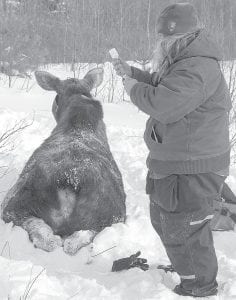DNR Wildlife Veterinarian Erika Butler, D.V.M. has been studying the moose as well as the mosquito in a quest to determine why the population has been dropping so drastically. Butler is pictured here earlier this winter as she prepares an injection that will reverse the effects of the tranquilizer and allow the now-collared moose to return unharmed to the wild.

Could mosquitoes be carrying diseases that kill Minnesota’s moose?
That’s just one of the questions the Minnesota Department of Natural Resources (DNR) is trying to answer as they try to unravel just what is killing Minnesota’s moose in stunningly quick fashion.
In 2012 the moose herd in Northeastern Minnesota declined by 35 percent and the DNR cancelled the bulls-only moose hunt for the coming season. In 2006 there was an estimated 8,840 moose in northeastern Minnesota and this past winter the number had fallen below 3,000.
Last summer and fall the DNR sent workers out into the field to capture mosquitoes for a study that could help explain why the moose are dying in northern Minnesota and may have implications for people.
According to Erika Butler, D.V.M., wildlife veterinarian for the DNR, 54,319 mosquitoes representing 29 species were collected and have been sent to the Minnesota Department of Health for Eastern Equine Encephalitis (EEE) and West Nile Virus (WNV) testing.
“We submitted 129 pools (or groups) of mosquitoes to the Minnesota Department of Health (MDH) for testing.
“Specimens were pooled by species, trap location, and trapping week. Because of the numbers, it took us a little bit to get them identified and sorted so they could be tested. They were brought to the MDH a little over a week ago and they believe the testing could be done in a few weeks.
“If we find EEE, we are hoping to trap again this year,” Butler said.
In the past Butler has described EEE as “West Nile Virus’s evil sister.”
According to the DNR, EEE is a rare but serious viral disease spread by mosquitoes that can affect both people and moose. Mosquitoes pick it up from feeding on infected birds and then spread it to livestock and people. Most people don’t become infected but for those who do the results can in some rare instances be fatal.
“While the driver of this [study] is moose health, the entomologists are also very excited to catalogue which species of mosquitoes we trap as it has been decades since someone had done anything like this,” Butler said.
In a related moose mortality study, the DNR radio collared 111 moose in January and so far six of the moose have died.
“Four of the deaths were “capture related,” as they fell into our two-week post-capture-related mortality window (where all deaths, regardless of the cause, are attributed to capture efforts). This is a rate of 3.6 percent which (while we don’t like it) is reasonable and actually lower than previous moose capture efforts in Minnesota. Capture-related mortalities increase as the body conditions and health status of the animals deteriorates, which we have seen in our northeast Minnesota moose studies.
“We had two official study mortalities. The first was a clear wolf kill (plenty of evidence of struggle, take down, etc.) while the second was a bit more interesting and required a bit of P.I. work from our field crew!
“It was an adult cow that had been bitten in the rump by wolves, but the wound didn’t kill it. There were wolf tracks in the area but they never got closer than 25 yards of the moose’s bed where she died.
“Right away, we wondered why they didn’t eat her? She was removed intact and brought to the veterinary diagnostic lab. Once there, it was clear these injuries were days—if not, up to a week, old. Again, why hadn’t the wolves finished their kill if they were so close to her?
“The necropsy revealed that the actual cause of death was an infection that traveled up into the abdomen and uterus. The field crew went back to the site and investigated the area she had been in up to a week prior to her death. They were also armed with the knowledge that she had a calf with her at capture. They were able to find that the wolves had taken down the calf and we concluded that the cow was bitten while defending her calf.
“The wolves were likely still full from the calf and may have been “catching” the cow for later…pretty interesting.
“While our first two mortalities were wolf kills, we don’t believe that wolves are playing a significant role in our moose decline (we have plenty of past data to support this). But, this is the season for wolf kills, so it is not that surprising.”


Loading Comments